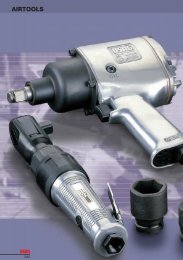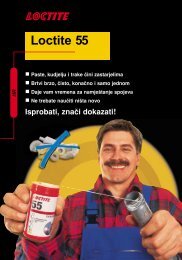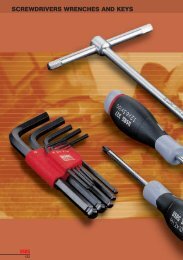Industrial seal self study guide - SKF.com
Industrial seal self study guide - SKF.com
Industrial seal self study guide - SKF.com
Create successful ePaper yourself
Turn your PDF publications into a flip-book with our unique Google optimized e-Paper software.
SEAL DESIGN GROUPS (cont.)<br />
All HS <strong>seal</strong>s require a cover plate<br />
for proper fit (fig. 3t).<br />
HS3<br />
The HS3 all-rubber <strong>seal</strong> has a spring<br />
held in an open groove, permitting<br />
easy access to the garter spring (fig. 3u).<br />
HS4<br />
The HS4 all-rubber <strong>seal</strong>’s spring is<br />
secured by a Spring-Lock (fig. 3v).<br />
HS5<br />
HS5 is the same as HS4, but with<br />
a Spring-Kover to provide added<br />
protection (fig. 3w).<br />
Cover Plates<br />
All HS type <strong>seal</strong>s, split and solid, require the end-user to fabricate and<br />
use a cover plate for proper fit (fig. 3t). The cover plate provides axial<br />
<strong>com</strong>pression and supplements radial press-fit to ensure a leakproof<br />
<strong>seal</strong>. Refer to Large Diameter Split Seal Installation section for details.<br />
Solid Designs (HS3, HS4, HS5)<br />
The differences between these three designs lie in the shape of the<br />
<strong>seal</strong>ing element and the method of retaining the garter spring.<br />
HS3<br />
HS3 is an all-rubber <strong>seal</strong> with a single spring-loaded element (fig. 3u).<br />
The spring is held in an open groove which permits easy access to the<br />
garter spring. This design is re<strong>com</strong>mended for vertical and horizontal<br />
shafts (Split version: HS9). Limited availability. All new machine<br />
designs, and field replacements, should be made with HS4 or HS5.<br />
HS4<br />
HS4 is an all-rubber <strong>seal</strong> with a single spring-loaded element (fig. 3v).<br />
The Spring-Lock secures the spring during installation regardless of<br />
the direction of shaft entry. It is re<strong>com</strong>mended for vertical and<br />
horizontal shafts and for use with a cover plate. It is used in steel mills,<br />
work rolls and other applications requiring frequent shaft removal<br />
and installation. (Split versions: HS6).<br />
HS5<br />
HS5 is identical to HS4, except that it also has a Spring-Kover (fig.<br />
3w). HS5 is re<strong>com</strong>mended in applications where materials could affect<br />
the garter spring or when installation can cause the spring to pop<br />
out (Split versions: HS7 and HS8). It can be used for vertical shaft<br />
assemblies in flooded conditions.<br />
Split Designs (HS6, HS7, HS8, HS9)<br />
Split <strong>seal</strong>s are re<strong>com</strong>mended in applications where downtime is<br />
critical and shaft disconnection is impractical. The split <strong>seal</strong> design<br />
offers a distinct advantage over solid <strong>seal</strong> types. It is placed around<br />
the shaft, the spring connected and then the <strong>seal</strong> is pushed into the<br />
<strong>seal</strong> bore. A cover plate provides axial and radial <strong>com</strong>pression<br />
and butts the split ends together.<br />
Split <strong>seal</strong>s perform best in grease applications or on well-lubricated<br />
horizontal applications where the oil is below the shaft centerline.<br />
Split <strong>seal</strong>s generally have poor pressure <strong>seal</strong>ing capability.<br />
20







